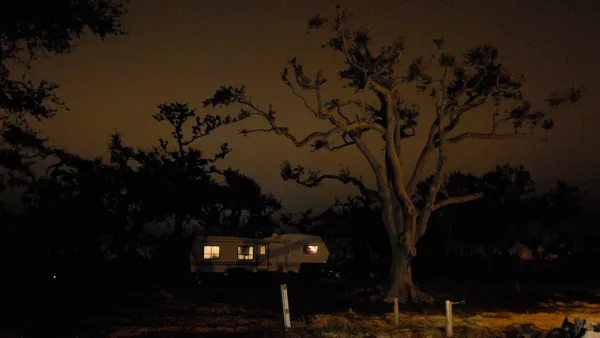On this week's KunstlerCast (James Howard Kunstler's podcast, with host Duncan Crary), you can hear me leaving a comment. I just listened to the episode, and I sound like I took a shot of codeine cough syrup before recording it. I think the point is relevant enough to reiterate in the safety of print.
On this week's KunstlerCast (James Howard Kunstler's podcast, with host Duncan Crary), you can hear me leaving a comment. I just listened to the episode, and I sound like I took a shot of codeine cough syrup before recording it. I think the point is relevant enough to reiterate in the safety of print.
In an earlier KunstlerCast, Jim was explaining the history of Seaside, FL, having just returned from accepting the Seaside Prize. Duncan expressed some skepticism about New Urbanism, saying that a "new urban" development had gone up near him, and in his book, had failed to be good urban planning. Clearly this project had flipped a switch in Duncan's head: New Urbanism is a bad thing.
Duncan's experience is common- New Urbanism has faced a backlash over recent years. The problem with this argument is that New Urbanism isn't the physical development in Duncan's neighborhood, or Seaside for that matter- it's a concept, a set of principles and guidelines, laid out very carefully in the Charter of the New Urbanism by a group of very smart architects and urbanists. The Charter is a manifesto, a call to arms:
We stand for the restoration of existing urban centers and towns within
coherent metropolitan regions, the reconfiguration of sprawling suburbs
into communities of real neighborhoods and diverse districts, the
conservation of natural environments, and the preservation of our built
legacy.
Sound good? How about this:
We advocate the restructuring of public policy and development
practices to support the following principles: neighborhoods should be
diverse in use and population; communities should be designed for the
pedestrian and transit as well as the car; cities and towns should be
shaped by physically defined and universally accessible public spaces
and community institutions; urban places should be framed by
architecture and landscape design that celebrate local history,
climate, ecology, and building practice.
So first of all, how many readers out there thought that New Urbanism = fancy molding and front porches? The New Urbanism is far more than that. The Charter is a Declaration of Independence, announcing a bold change in thinking back in 1996 for how neighborhoods, districts, and cities should be planned and built.
 In the KunstlerCast episode (#51), Jim compares new development to an omelette. His point was that newer built environments need time to 'cook' before they become accepted into their surroundings. But to extend the analogy, New Urbanism is like a fine recipe. Developed by the top chefs, the recipe is written to produce the most delicious omelette you've ever tasted. Cities, developers, and well-minded folks take the recipe and substitute ingredients, replacing the organic filet mignon the recipe calls for with ground round. Then they start changing the recipe to conform more to previous recipes that they cooked before and worked for them in the past. Then a bunch of other people come into the kitchen and start throwing in their own ingredients and partial recipes. Is it any surprise you end up with a crappy omelette?
In the KunstlerCast episode (#51), Jim compares new development to an omelette. His point was that newer built environments need time to 'cook' before they become accepted into their surroundings. But to extend the analogy, New Urbanism is like a fine recipe. Developed by the top chefs, the recipe is written to produce the most delicious omelette you've ever tasted. Cities, developers, and well-minded folks take the recipe and substitute ingredients, replacing the organic filet mignon the recipe calls for with ground round. Then they start changing the recipe to conform more to previous recipes that they cooked before and worked for them in the past. Then a bunch of other people come into the kitchen and start throwing in their own ingredients and partial recipes. Is it any surprise you end up with a crappy omelette?
You see my point. Discussions of New Urbanism need to separate the concept from the execution. Granted, the whole point is to get good things built, so if the recipe is so open to interpretation that you're getting crappy omelettes everywhere, there's a problem. But I guess if you extend my analogy, what you really need are more good chefs who understand how to bring the recipe to life.

Analysis: Cybertruck Fatality Rate Far Exceeds That of Ford Pinto
The Tesla Cybertruck was recalled seven times last year.

National Parks Layoffs Will Cause Communities to Lose Billions
Thousands of essential park workers were laid off this week, just before the busy spring break season.

Retro-silient?: America’s First “Eco-burb,” The Woodlands Turns 50
A master-planned community north of Houston offers lessons on green infrastructure and resilient design, but falls short of its founder’s lofty affordability and walkability goals.

Test News Post 1
This is a summary

Analysis: Cybertruck Fatality Rate Far Exceeds That of Ford Pinto
The Tesla Cybertruck was recalled seven times last year.

Test News Headline 46
Test for the image on the front page.
Urban Design for Planners 1: Software Tools
This six-course series explores essential urban design concepts using open source software and equips planners with the tools they need to participate fully in the urban design process.
Planning for Universal Design
Learn the tools for implementing Universal Design in planning regulations.
EMC Planning Group, Inc.
Planetizen
Planetizen
Mpact (formerly Rail~Volution)
Great Falls Development Authority, Inc.
HUDs Office of Policy Development and Research
NYU Wagner Graduate School of Public Service



























